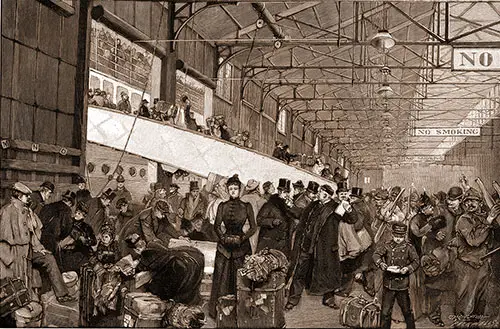The Importance of the Immigrant Trade - Ocean Passenger Travel
It must not be supposed that passengers are all immigrants. Odd as it may seem, there are many world wanderers who cross and re-cross in the , who travel over great parts of the world, and who, in their class, are as independent as the more luxuriously accommodated cabin people.
Besides these curious characters there are Scottish carpenters and other mechanics who come over here for a few months at a time to take advantage of higher wages, and who return as they came when Christmas draws nigh.
It will doubtless cause astonishment to most readers to learn that when the Teutonic made her last voyage to Europe, in December, 1890, she carried 1,400 passengers, more than 1,000 of whom were in the steerage.
The immigrant business has come to be so important a feature in transatlantic passenger traffic, that it may not be uninteresting to conclude this article with a few figures that show somewhat of its growth and proportions, and also the method of handling the immigrants.
At least eighty-five percent of all immigration to the United States comes through the port of New York. The Board of Immigration was not established until 1847, and previous to that time records were rather loosely kept.
The official figures, however, have been obtained,* showing that between 1783 and 1847, 1,063,567 immigrants came to this country; between 1847 and 1873 there were 4,933,562; a marked falling off in the annual average occurring during the War of the Rebellion; between 1873 and 1890, inclusive, 4,910,864.
Immigration was heaviest in the years 1881, 1882, and 1883, the figures being 441,064; 455,450; and 388,267, respectively.
The greatest arrival of immigrants in any one day was on May 11, 1887, when nearly 10,000 were landed at this port. The greatest number ever brought by a single ship was 1,767, by the Egypt, National Line, in 1873. This good ship was destroyed by fire, July, 1890, in mid ocean, on her way to the eastward, but fortunately not a life was lost.
On the arrival of each vessel at her dock she is boarded by the Immigration Department boarding officer, and the Customs inspector and his assistants; the latter examine the immigrants' baggage, and sometimes add considerable to Uncle Samuel's bank account in the way of duties or the confiscation of smuggled articles.

Passengers Arrive in New York - The End of the Voyage circa 1890
Their baggage is then checked and placed on board the transfer boats and barges, which convey them to the Barge Office, where they are examined by a medical staff and then passed to the registration department in that building.
Here they give their name, age, occupation, nationality, and destination; if they appear as though they were liable to become a public charge, in compliance with an Act of Congress, they are returned, by the same vessel on which they arrived, to the place from which they came.
But an opportunity is given to their friends, if any should call, to guarantee that they will not become a public charge, and they are then allowed to leave the department in the custody of their friends.
Parties seeking friends call at the information bureau, and if they satisfy the clerk as to their identity they are allowed to take their friends away. On leaving the steamship checks are given to them for their baggage, and it is stored at the Barge Office free of charge, and kept till called for.
There is a railroad ticket office in the Barge Office, where all the trunk lines are represented by one general agent, a sort of pool, and here the immigrant can secure tickets to any point and have baggage checked to destination; and at no other place can tickets be procured at such low rates, nor can anyone but an immigrant get such a low rate.
Each immigrant is allowed 150 pounds of baggage free, and the railroad companies transfer them and their baggage from the Barge Office to their respective depots free of charge.
A temporary hospital is located in the Barge Office, where immigrants not seriously ill are kept, and those who may have any serious illness are sent to hospitals under contract with the department for such patients.
Each steamship company was formerly required to pay to the United States Treasury a head tax of $2.50 for each alien passenger; this fee was reduced to $1.00, and some years ago it was still further reduced to fifty cents, the present rate. This tax goes to what is known as the Immigrant Fund.
Through the courtesy of Mr. George W. Esslinger, assistant to Captain John E. Moore, landing agent.
Ocean Passenger Travel - 1891
- Chapter 1: Overview of Transatlantic Travel
- Chapter 2: Room on the Early Steamers
- Chapter 3: The Collins Line, The Inman Company, Beginnings of the White Star Line
- Chapter 4: The Speed of the 1890 Steamships
- Chapter 5: Transatlantic Passengers and the Buildup of Fleets
- Chapter 6: Provisions and Meals on an 1890s Ocean Liner
- Chapter 7: Procedures for processing Immigrants onboard Steamships
- Chapter 8: The Importance of the Immigrant Trade
Gould, John H. "Ocean Passenger Travel", Scribner's Magazine, Vol. IX, No. 4, April 1891, pp. 399-419
